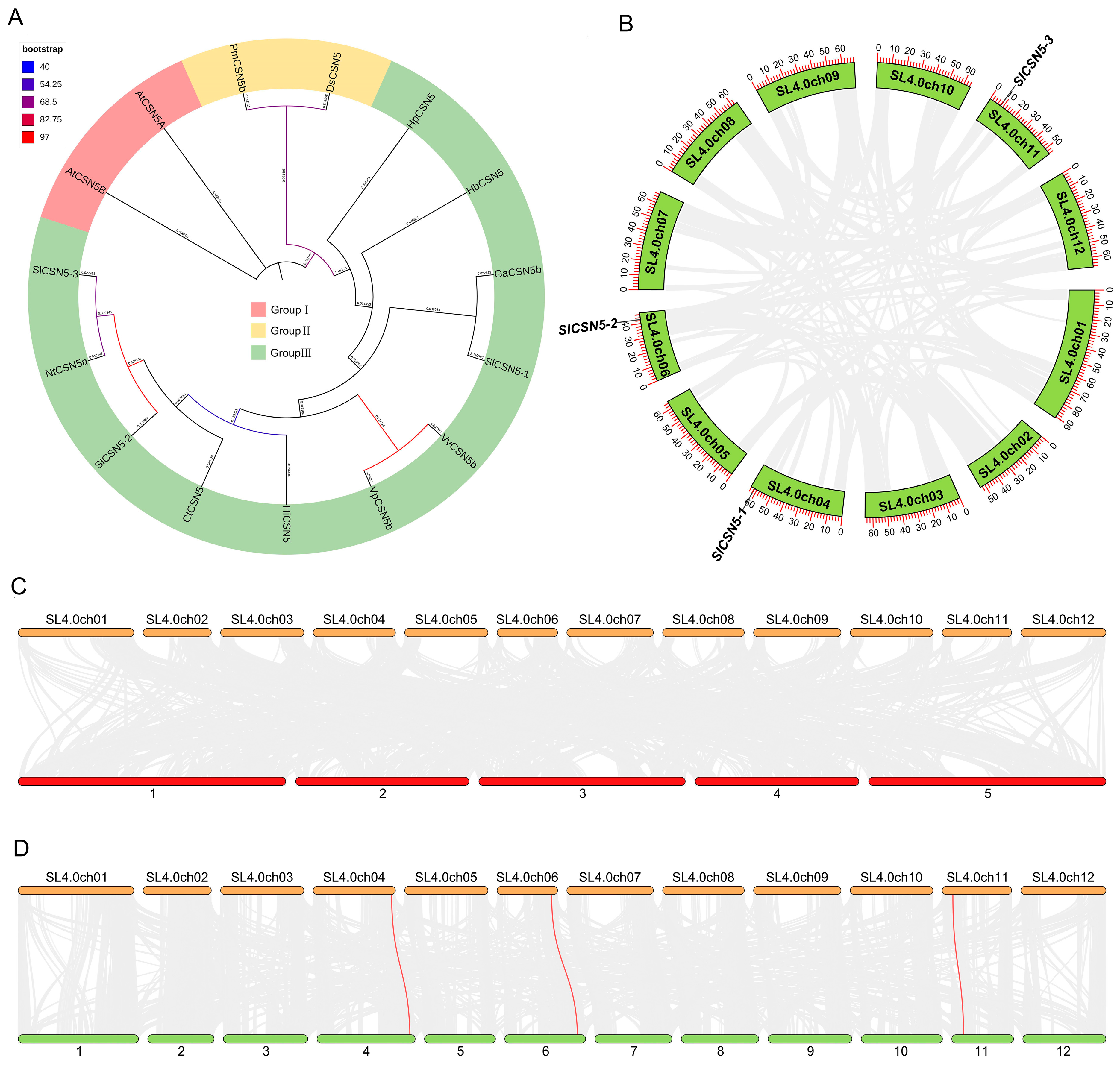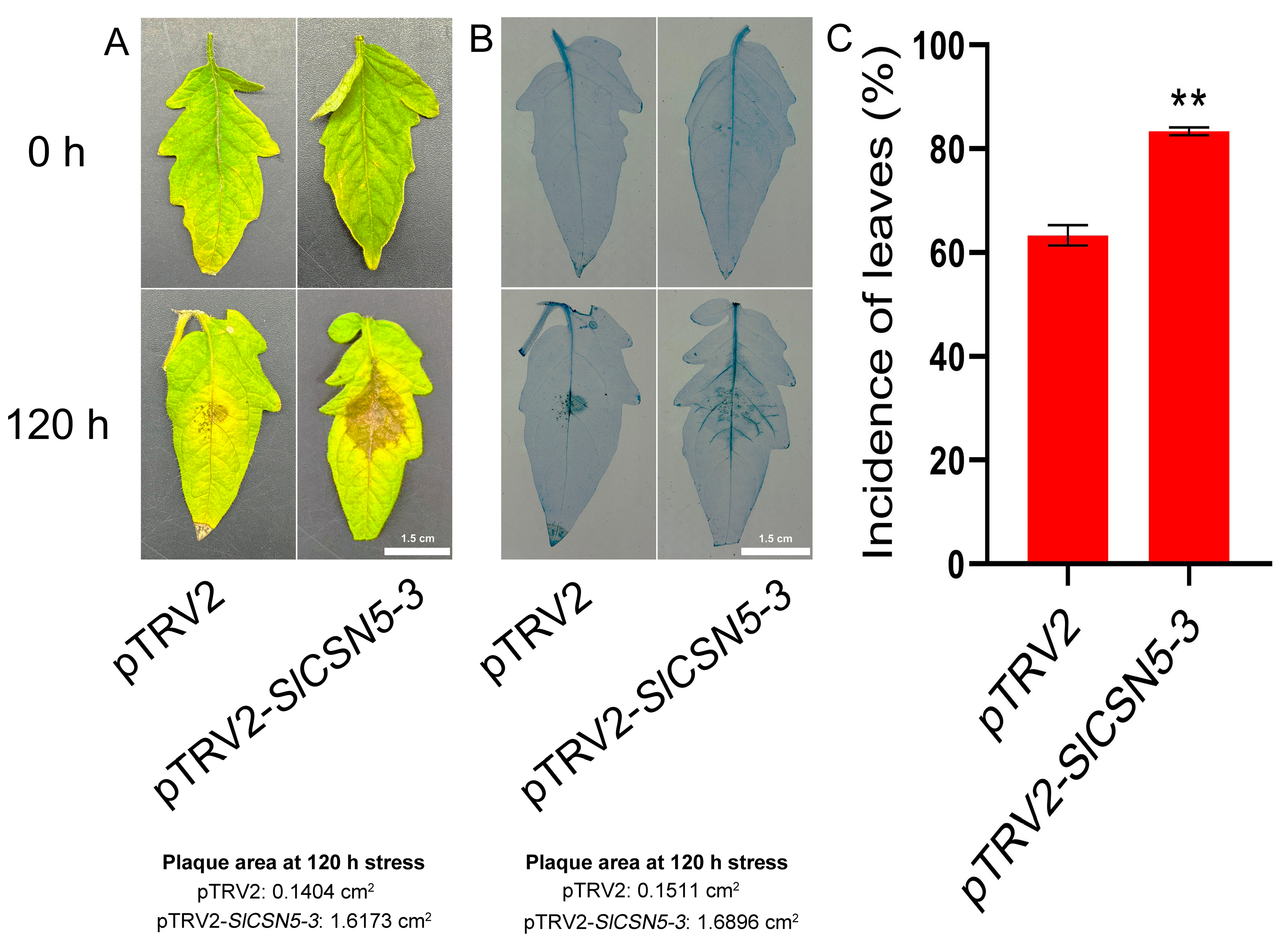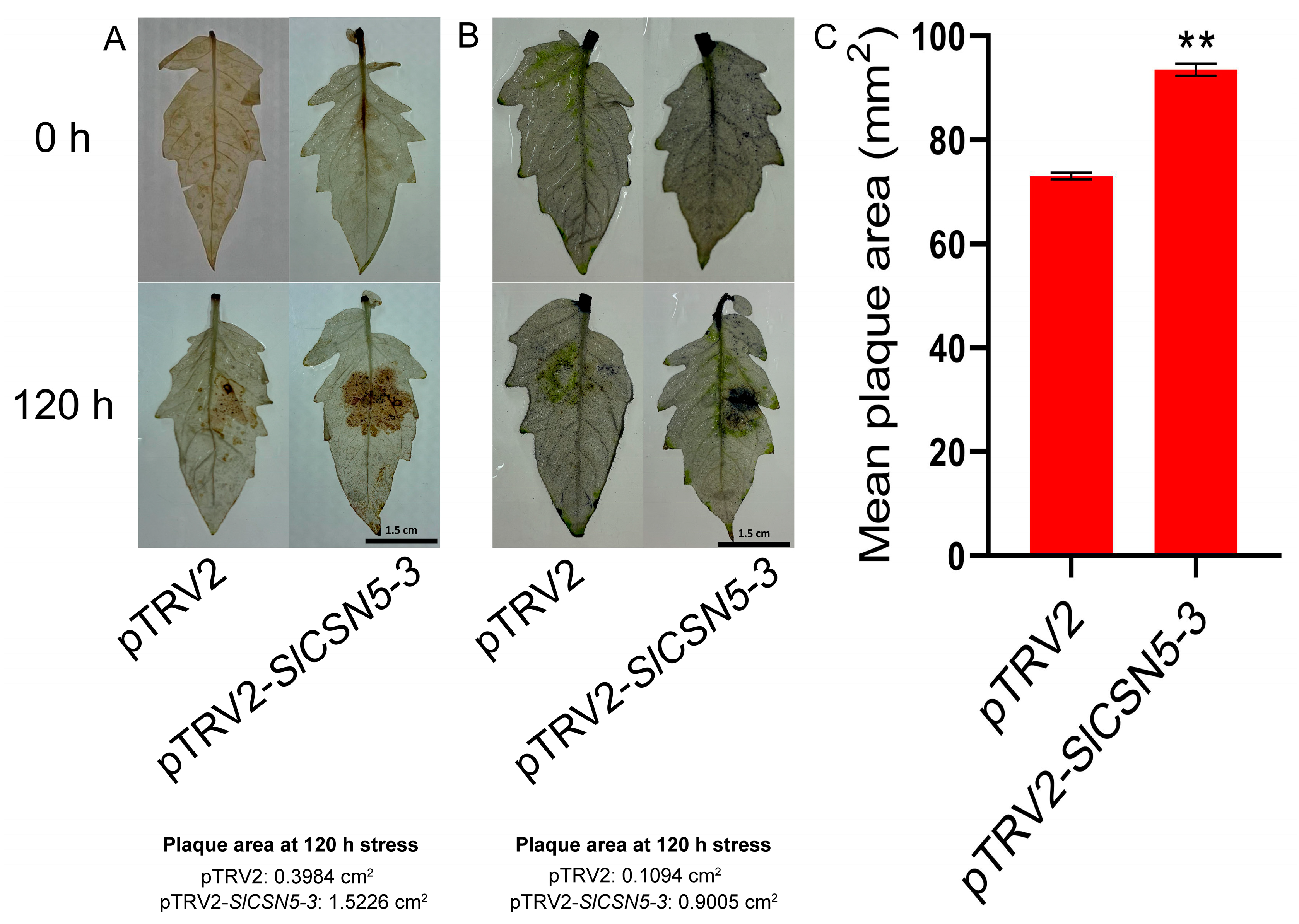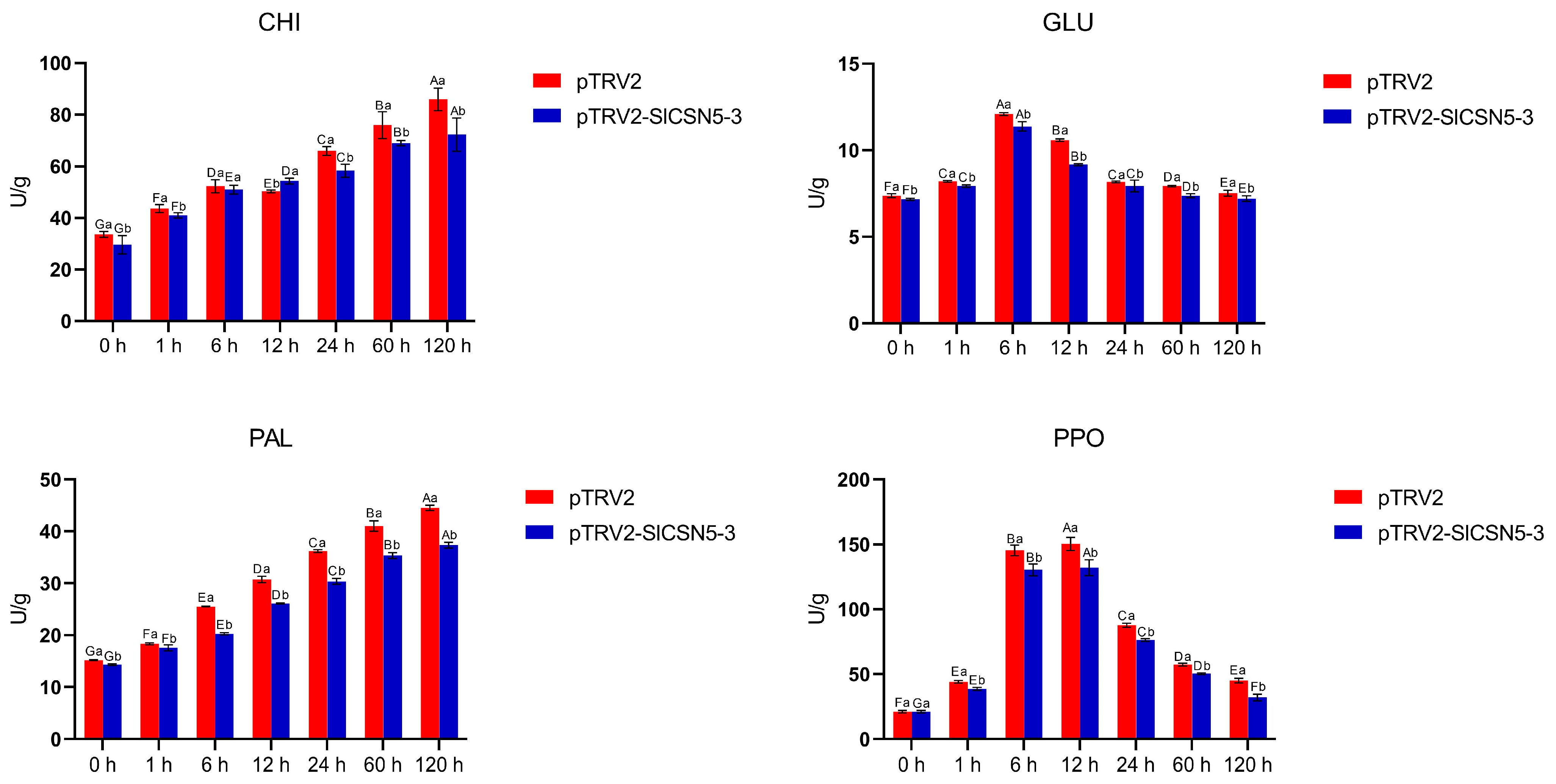COP9 Signalosome Subunit SlCSN5-3 Positively Regulates Resistance to Gray Mold Disease in Tomato (Solanum lycopersicum) Through Jasmonic Acid Pathway
Simple Summary
Abstract
1. Introduction
2. Materials and Methods
2.1. Plant Materials and Microbial Stress
2.2. Identification of Tomato CSN5 Family Members
2.3. Analysis of Chromosomal Localization and Protein Physicochemical Properties of Tomato CSN5 Family Members
2.4. Gene Structure Analysis and Protein Conserved Motif and Domain Analysis of Tomato CSN5 Family Members
2.5. Phylogenetic Analysis
2.6. Collinearity and Synteny Analysis of CSN5 Family Genes
2.7. Analysis of Cis-Acting Elements in Promoter
2.8. Transcriptome Data Analysis of Tomato CSN5 Family Genes Under Gray Mold Disease Stress
2.9. Total RNA Extraction and qRT-PCR Analysis
2.10. Silencing SlCSN5-3 in Tomatoes by VIGS
2.11. Phenotype Observation, Disease Statistics, and Physiological Indicators
2.12. Hormone Content and Expression of Core Genes in Their Pathway
2.13. Statistical Analyses
2.14. Experiment Repetition
3. Results
3.1. Identification of CSN5 Family Genes in Tomato
3.2. Chromosomal Localization of CSN5 Family Genes in Tomatoes and Physicochemical Properties of Encoded Proteins
3.3. Structural Analysis of Tomato CSN5 Family Genes and Analysis of Conserved Motifs and Domains of Their Encoded Proteins
3.4. Phylogenetic Analysis of CSN5 Family Proteins
3.5. Collinearity Analysis of CSN5 Family Genes
3.6. Analysis of Cis-Acting Elements in the Promoters of Tomato CSN5 Family Genes
3.7. Transcriptome Data and qRT-PCR Analysis of Tomato CSN5 Family Genes Under Gray Mold Disease Stress
3.8. Silencing of SlCSN5-3 in Tomatoes by VIGS
3.9. Silencing of SlCSN5-3 Reduced Tomatoes’ Resistance to Gray Mold Disease
3.10. SlCSN5-3 Positively Regulates Tomatoes’ Resistance to Gray Mold Disease by Affecting the JA Pathway
4. Discussion
5. Conclusions
Supplementary Materials
Author Contributions
Funding
Institutional Review Board Statement
Informed Consent Statement
Data Availability Statement
Conflicts of Interest
Abbreviations
| CSN | Constitutive photomorphogenesis 9 |
| JA | Jasmonic acid |
| MPN | Mprl-Padl-N-teminal |
| eIF3 | Eukaryotic initiation factor 3 |
| UPS | Ubiquitin/26S protease system |
| CDS | Coding sequence |
| HMM | Hidden Markov model |
| VIGS | Virus-induced gene silencing |
| DAB | Diaminobenzidine |
| NBT | Nitrotetrazolium blue |
| CHI | Chitinase |
| PAL | Phenylalanine ammonia lyase |
| GLU | β-1,3-glucanase |
| PPO | Polyphenol oxidase |
| SA | Salicylic acid |
| UTR | Untranslated region |
References
- Suzuki, G.; Yanagawa, Y.; Kwok, S.F.; Matsui, M.; Deng, X.W. Arabidopsis COP10 is a ubiquitin-conjugating enzyme variant that acts together with COP1 and the COP9 signalosome in repressing photomorphogenesis. Genes Dev. 2002, 16, 554–559. [Google Scholar] [CrossRef]
- Chamovitz, D.A.; Wei, N.; Osterlund, M.T.; von Arnim, A.G.; Staub, J.M.; Matsui, M.; Deng, X.W. The COP9 complex, a novel multisubunit nuclear regulator involved in light control of a plant developmental switch. Cell 1996, 86, 115–121. [Google Scholar] [CrossRef]
- Wei, N.; Chamovitz, D.A.; Deng, X.W. Arabidopsis COP9 is a component of a novel signaling complex mediating light control of development. Cell 1994, 78, 117–124. [Google Scholar] [CrossRef] [PubMed]
- Peng, Z.; Serino, G.; Deng, X.W. Molecular characterization of subunit 6 of the COP9 signalosome and its role in multifaceted developmental processes in Arabidopsis. Plant Cell 2001, 13, 2393–2407. [Google Scholar] [CrossRef] [PubMed]
- Gusmaroli, G.; Figueroa, P.; Serino, G.; Deng, X.W. Role of the MPN subunits in COP9 signalosome assembly and activity, and their regulatory interaction with Arabidopsis Cullin3-based E3 ligases. Plant Cell 2007, 19, 564–581. [Google Scholar] [CrossRef]
- Schwechheimer, C.; Deng, X.W. COP9 signalosome revisited: A novel mediator of protein degradation. Trends Cell Biol. 2001, 11, 420–426. [Google Scholar] [CrossRef]
- Kwok, S.F.; Solano, R.; Tsuge, T.; Chamovitz, D.A.; Ecker, J.R.; Matsui, M.; Deng, X.W. Arabidopsis homologs of a c-Jun coactivator are present both in monomeric form and in the COP9 complex, and their abundance is differentially affected by the pleiotropic cop/det/fus mutations. Plant Cell 1998, 10, 1779–1790. [Google Scholar] [CrossRef]
- Jin, D.; Wu, M.; Li, B.; Bucker, B.; Keil, P.; Zhang, S.; Li, J.; Kang, D.; Liu, J.; Dong, J.; et al. The COP9 Signalosome regulates seed germination by facilitating protein degradation of RGL2 and ABI5. PLoS Genet. 2018, 14, e1007237. [Google Scholar] [CrossRef] [PubMed]
- Hind, S.R.; Pulliam, S.E.; Veronese, P.; Shantharaj, D.; Nazir, A.; Jacobs, N.S.; Stratmann, J.W. The COP9 signalosome controls jasmonic acid synthesis and plant responses to herbivory and pathogens. Plant J. 2011, 65, 480–491. [Google Scholar] [CrossRef]
- Lv, L.X.; Zhang, Q.; Zhao, X.F.; Wang, J.X. Identification of COP9 signalosome (CSN) subunits and antiviral function analysis of CSN5 in shrimp. Fish Shellfish Immunol. 2024, 151, 109679. [Google Scholar] [CrossRef]
- Zhang, J.; Zhang, Z.; Zhang, R.; Zhang, W.; Li, H.; Li, T.; Zhang, H.; Zheng, W. Identification of COP9 signalosome subunit genes in Bactrocera dorsalis and functional analysis of csn3 in female fecundity. Front. Physiol. 2019, 10, 162. [Google Scholar] [CrossRef]
- Li, L.; Li, T.; Xu, T.; Qi, M.; Yu, Z.; Zhang, K. Role of calcium in tomato Lycopersicon esculentum Millresistance to Botrytis cinerea. Afr. J. Biotechnol. 2012, 11, 9013–9022. [Google Scholar] [CrossRef]
- Chen, C.; Wu, Y.; Li, J.; Wang, X.; Zeng, Z.; Xu, J.; Liu, Y.; Feng, J.; Chen, H.; He, Y.; et al. TBtools-II: A “one for all, all for one” bioinformatics platform for biological big-data mining. Mol. Plant 2023, 16, 1733–1742. [Google Scholar] [CrossRef]
- Meng, F.; Lv, R.; Cheng, M.; Mo, F.; Zhang, N.; Qi, H.; Liu, J.; Chen, X.; Liu, Y.; Ghanizadeh, H.; et al. Insights into the molecular basis of biocontrol of Botrytis cinerea by Clonostachys rosea in tomato. Sci. Hortic. 2022, 291, 110547. [Google Scholar] [CrossRef]
- Livak, K.J.; Schmittgen, T.D. Analysis of relative gene expression data using real-time quantitative PCR and the 2(-Delta Delta C(T)) method. Methods 2001, 25, 402–408. [Google Scholar] [CrossRef] [PubMed]
- Yan, P.; Zeng, Y.; Shen, W.; Tuo, D.; Li, X.; Zhou, P. Nimble cloning: A simple, versatile, and efficient system for standardized molecular cloning. Front. Bioeng. Biotechnol. 2019, 7, e460. [Google Scholar] [CrossRef]
- Chen, X.; Lv, R.; Zhang, Y.; Mo, F.; Meng, F.; Cheng, M.; Huang, X.; Qi, H.; Wang, A. Identification of the NCED gene family in tomato (Solanum lycopersicum) and functional analysis of SlNCED2 in response to drought stress. Sci. Hortic. 2024, 330, 113087. [Google Scholar] [CrossRef]
- Li, F.; Ghanizadeh, H.; Song, W.; Miao, S.; Wang, H.; Chen, X.; Liu, J.; Wang, A. Combined use of Trichoderma harzianum and Clonostachys rosea to manage Botrytis cinerea infection in tomato plants. Eur. J. Plant Pathol. 2023, 167, 637–650. [Google Scholar] [CrossRef]
- Chen, H.; Chen, X.; Chen, D.; Li, J.; Zhang, Y.; Wang, A. A comparison of the low temperature transcriptomes of two tomato genotypes that differ in freezing tolerance: Solanum lycopersicum and Solanum habrochaites. BMC Plant Biol. 2015, 15, 132. [Google Scholar] [CrossRef]
- Mostofa, M.G.; Rahman, A.; Ansary, M.M.U.; Watanabe, A.; Fujita, M.; Tran, L.P. Hydrogen sulfide modulates cadmium-induced physiological and biochemical responses to alleviate cadmium toxicity in rice. Sci. Rep. 2015, 5, 14078. [Google Scholar] [CrossRef]
- Shu, P.; Zhang, S.; Li, Y.; Wang, X.; Yao, L.; Sheng, J.; Shen, L. Over-expression of SlWRKY46 in tomato plants increases susceptibility to Botrytis cinerea by modulating ROS homeostasis and SA and JA signaling pathways. Plant Physiol. Biochem. 2021, 166, 1–9. [Google Scholar] [CrossRef] [PubMed]
- Zhang, M.; Han, H.; Li, Y.; Zhang, M.; Lian, J.; Geng, M.; Zhao, J.; Chen, Q.; Zhai, H.; Meng, X.; et al. Overexpression of DRM2 increases resistance to Botrytis cinerea by modulating JA signalling pathway in tomato. Plant Cell Environ. 2025, 1, 1–14. [Google Scholar] [CrossRef] [PubMed]
- Panebianco, S.; Americo, S.; Piero, A.R.L.; Cirvilleri, G. Biocontrol activity of novel and known bioproducts based on Bacillus strains and basic products against Botrytis cinerea in tomato fruit. Biol. Control 2025, 206, 105780. [Google Scholar] [CrossRef]
- Xiang, L.; Li, Y.; Shu, P.; Sheng, J.; Shen, L. Knockout of SlCBF1 enhances tomato fruit resistance against Botrytis cinerea after chilling stress treatment. Postharvest Biol. Technol. 2025, 227, 113613. [Google Scholar] [CrossRef]
- Araújo, E.R.; Resende, R.S.; Rossato, M. Evaluation of foliar sprays of thymol and carvacrol for controlling Botrytis leaf blight of onion: A field trial. Eur. J. Plant Pathol. 2025, 1, 1–6. [Google Scholar] [CrossRef]
- Hao, L.; Zhang, Y.; Ge, Z.; Meng, X.; Sun, Y.; Yi, H. Transient overexpression of VvMYBPA1 in grape berries enhances susceptibility to Botrytis cinerea through ROS homeostasis modulation. Plants 2025, 14, 2469. [Google Scholar] [CrossRef]
- Li, S.; Wang, M.; Du, X.; Wang, Y.; Pan, Y.; Ji, D.; You, J.; Shan, M.; Bao, G.; Liu, X.; et al. The GmPRL1b-GmST2-GmAOC3/4 module confers salt tolerance and Botrytis cinerea resistance by inducing jasmonic acid biosynthesis in soybean. Plant Biotechnol. J. 2025, 1–19. [Google Scholar] [CrossRef]
- Jin, D.; Li, B.; Deng, X.W.; Wei, N. Plant COP9 signalosome subunit 5, CSN5. Plant Sci. 2014, 224, 54–61. [Google Scholar] [CrossRef]
- Zhang, Y.; Meng, J.; Xu, F. Genome-wide identification of the PP1 and PPP1R3 gene family in oyster Crassostrea gigas: Unraveling their roles in glycogen metabolism. Aquac. Rep. 2024, 37, 102258. [Google Scholar] [CrossRef]
- Mo, F.; Xue, X.; Meng, L.; Zhang, Y.; Cui, Y.; Liu, J.; Cheng, M.; Wang, P.; Lv, R.; Meng, F.; et al. Genome-wide identification and expression analysis of SLAC1 gene family in tomato (Solanum lycopersicum) and the function of SlSLAC1–6 under cold stress. Sci. Hortic. 2023, 313, 111904. [Google Scholar] [CrossRef]
- Li, S.; Gao, X.; Chen, J.; Li, H.; Yi, L.; Ming, J.; Zeng, K. Genome-wide characterization of the CsGPAT gene family and functional insights into citrus fruit wound healing. Postharvest Biol. Technol. 2026, 232, 113969. [Google Scholar] [CrossRef]
- Wang, B.; Liu, W.; Gan, H.; Lv, Y.; Hu, X.; Wang, T.; Zhao, X. Genome-wide identification of BBX gene family and its function in defense of necrotrophic fungus Alternaria sp. in Chrysanthemum. BMC Genom. 2025, 26, 942. [Google Scholar] [CrossRef] [PubMed]
- Arif, M.; Abbas, H.; Mahmood, N.; Uzair, M.; Manzoor, M.A.; Tung, S.A.; Xin, Y.; Xu, R.; Li, L. Genome-Wide analysis of the NRAMP gene family in Arabidopsis thaliana: Identification, expression and response to multiple heavy metal stresses and phytohormones. BMC Plant Biol. 2025, 25, 1305. [Google Scholar] [CrossRef]
- Lian, C.; Li, Q.; Yao, K.; Zhang, Y.; Meng, S.; Yin, W.; Xia, X. Populus trichocarpa PtNF-YA9, a multifunctional transcription factor, regulates seed germination, abiotic stress, plant growth and development in Arabidopsis. Front. Plant Sci. 2018, 9, 954. [Google Scholar] [CrossRef]
- Xu, X.; Liu, Y.; Bai, Z.; Jia, L.; Yu, C.; Tanveer, M.; Shabala, S.; Huang, L. Tissue-specific expression and genome-wide analysis of RALF gene family in pea (Pisum sativum L.) under different stresses. Plant Stress 2025, 18, 101056. [Google Scholar] [CrossRef]
- Ghouili, E.; Muhovski, Y.; Hogue, R.; Ouertani, R.N.; Abdelkrim, S.; Li, Z.; Souissi, F.; Jebara, S.H.; Jebara, M.; Abid, G. Effects of compost and biochar on barley’s growth and response to drought stress: Insights into osmoprotectants, antioxidant activity, and gene expression. J. Soil Sci. Plant Nutr. 2025, 1–17. [Google Scholar] [CrossRef]
- Saskia, V.W. Phenotypic analysis of Arabidopsis mutants: Trypan blue stain for fungi, oomycetes, and dead plant cells. Cold Spring Harb. Protoc. 2008, 2008, pdb.prot4982. [Google Scholar] [CrossRef] [PubMed]
- Kerschbaum, H.H.; Altuğ, T.B.; Melanie, S.; Karin, O.; Nikolaus, B. Trypan blue-adapting a dye used for labelling dead cells to visualize pinocytosis in viable cells. Cell. Physiol. Biochem. Int. J. Exp. Cell. Physiol. Biochem. Pharmacol. 2021, 55, 171–184. [Google Scholar] [CrossRef]
- Walum, E.; Peterson, A.; Erkell, L.J. Photometric recording of cell viability using trypan blue in perfused cell cultures. Xenobiotica 2009, 15, 8–704. [Google Scholar] [CrossRef] [PubMed]
- Hasanuzzaman, M.; Bhuyan, M.H.M.B.; Zulfiqar, F.; Raza, A.; Mohsin, S.M.; Mahmud, J.A.; Fujita, M.; Fotopoulos, V. Reactive oxygen species and antioxidant defense in plants under abiotic stress: Revisiting the crucial role of a universal defense regulator. Antioxidants 2020, 9, 681. [Google Scholar] [CrossRef]
- Pieterse, C.M.; Van der Does, D.; Zamioudis, C.; Leon-Reyes, A.; Van Wees, S.C. Hormonal modulation of plant immunity. Annu. Rev. Cell Dev. Biol. 2012, 28, 489–521. [Google Scholar] [CrossRef] [PubMed]
- Fabra, R.O.; Giraldo, C.G.; Giner, M.A.F.; Urbaneja, A.; Hedo, M.P. Genotype-dependent responses to HIPV exposure in citrus: Repression of CsPUB21 and activation of SA/JA signaling. Front. Plant Sci. 2025, 16, 1605151. [Google Scholar] [CrossRef]
- Zheng, X.; Long, Y.; Liu, X.; Han, G.; Geng, X.; Ju, X.; Chen, W.; Xu, T.; Tang, N. RcWRKY40 regulates the antagonistic SA–JA pathway in response to Marssonina rosae infection. Sci. Hortic. 2024, 332, 113178. [Google Scholar] [CrossRef]
- Li, J.; Brader, G.; Palva, E.T. The WRKY70 transcription factor: A node of convergence for jasmonate-mediated and salicylate-mediated signals in plant defense. Plant Cell 2004, 16, 319–331. [Google Scholar] [CrossRef]
- Mur, L.A.; Kenton, P.; Atzorn, R.; Miersch, O.; Wasternack, C. The outcomes of concentration-specific interactions between salicylate and jasmonate signaling include synergy, antagonism, and oxidative stress leading to cell death. Plant Physiol. 2006, 140, 249–262. [Google Scholar] [CrossRef]
- Williamson, B.; Tudzynski, B.; Tudzynski, P.; van Kan, J.A. Botrytis cinerea: The cause of grey mould disease. Mol. Plant Pathol. 2007, 8, 561–580. [Google Scholar] [CrossRef]
- Synan, A.; Khaled, M.; Son, T.L. Mechanisms and strategies of plant defense against Botrytis cinerea. Crit. Rev. Biotechnol. 2017, 37, 262–274. [Google Scholar] [CrossRef] [PubMed]
- Nakajima, M.; Akutsu, K. Virulence factors of Botrytis cinerea. J. Gen. Plant Pathol. 2014, 80, 15–23. [Google Scholar] [CrossRef]
- Li, N.; Uhrig, J.F.; Thurow, C.; Huang, L.J.; Gatz, C. Reconstitution of the jasmonate signaling pathway in plant protoplasts. Cells 2019, 8, 1532. [Google Scholar] [CrossRef] [PubMed]
- Glazebrook, J. Contrasting mechanisms of defense against biotrophic and necrotrophic pathogens. Annu. Rev. Phytopathol. 2005, 43, 205–227. [Google Scholar] [CrossRef] [PubMed]
- Punja, Z.K.; Zhang, Y.Y. Plant chitinases and their roles in resistance to fungal diseases. J. Nematol. 1993, 25, 526–540. [Google Scholar]
- Hyun, M.W.; Yun, Y.H.; Kim, J.Y.; Kim, S.H. Fungal and plant phenylalanine ammonia-lyase. Mycobiology 2011, 39, 257–265. [Google Scholar] [CrossRef] [PubMed]
- Beffa, R.S.; Hofer, R.M.; Thomas, M.; Meins, F.J. Decreased susceptibility to viral disease of [beta]-1,3-glucanase-deficient plants generated by antisense transformation. Plant Cell 1996, 8, 1001–1011. [Google Scholar] [CrossRef]
- Thipyapong, P.; Stout, M.J.; Attajarusit, J. Functional analysis of polyphenol oxidases by antisense/sense technology. Molecules 2007, 12, 1569–1595. [Google Scholar] [CrossRef] [PubMed]









Disclaimer/Publisher’s Note: The statements, opinions and data contained in all publications are solely those of the individual author(s) and contributor(s) and not of MDPI and/or the editor(s). MDPI and/or the editor(s) disclaim responsibility for any injury to people or property resulting from any ideas, methods, instructions or products referred to in the content. |
© 2025 by the authors. Licensee MDPI, Basel, Switzerland. This article is an open access article distributed under the terms and conditions of the Creative Commons Attribution (CC BY) license (https://creativecommons.org/licenses/by/4.0/).
Share and Cite
Lv, R.; Sun, H.; Mo, F.; Liu, S.; Liu, Z.; Chen, X.; Liu, Y.; Wang, A. COP9 Signalosome Subunit SlCSN5-3 Positively Regulates Resistance to Gray Mold Disease in Tomato (Solanum lycopersicum) Through Jasmonic Acid Pathway. Biology 2025, 14, 1635. https://doi.org/10.3390/biology14121635
Lv R, Sun H, Mo F, Liu S, Liu Z, Chen X, Liu Y, Wang A. COP9 Signalosome Subunit SlCSN5-3 Positively Regulates Resistance to Gray Mold Disease in Tomato (Solanum lycopersicum) Through Jasmonic Acid Pathway. Biology. 2025; 14(12):1635. https://doi.org/10.3390/biology14121635
Chicago/Turabian StyleLv, Rui, Hecheng Sun, Fulei Mo, Shusen Liu, Zhao Liu, Xiuling Chen, Yuxin Liu, and Aoxue Wang. 2025. "COP9 Signalosome Subunit SlCSN5-3 Positively Regulates Resistance to Gray Mold Disease in Tomato (Solanum lycopersicum) Through Jasmonic Acid Pathway" Biology 14, no. 12: 1635. https://doi.org/10.3390/biology14121635
APA StyleLv, R., Sun, H., Mo, F., Liu, S., Liu, Z., Chen, X., Liu, Y., & Wang, A. (2025). COP9 Signalosome Subunit SlCSN5-3 Positively Regulates Resistance to Gray Mold Disease in Tomato (Solanum lycopersicum) Through Jasmonic Acid Pathway. Biology, 14(12), 1635. https://doi.org/10.3390/biology14121635






